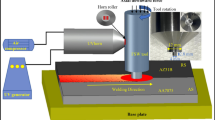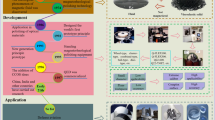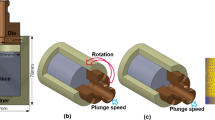Abstract
This study explores the relationship between revolution pitch, heat generation, and flow properties in polypropylene friction stir welding joints. Utilizing a modified computational fluid dynamics method, simulations of polypropylene friction stir welding are conducted to elucidate material flow and thermal history in relation to revolution pitch. The study investigates the impact of revolution pitch on internal defects, hardness, and tensile strength of the polypropylene joint. Simulation results reveal that revolution pitch influences polypropylene strain rate and viscosity, leading to variations in internal voids within the stir zone. A higher revolution pitch results in vertical mixing, while a lower revolution pitch causes horizontal lamellar mixing in the stir zone. Controlling revolution pitch is crucial for producing robust joints, as a very low revolution pitch increases the risk of over-stirring and air tapping, while a very high revolution pitch hinders proper joint formation. The optimal heat range for robust joint formation is identified between ~175 (revolution pitch = 0.0410) and ~210 °C. (at revolution pitch = 0.0107). The study demonstrates that consistent polypropylene joint properties can be achieved with similar revolution pitch, even at different friction stir welding tool velocities.











Similar content being viewed by others
Data availability
Not applicable.
Abbreviations
- P :
-
Pressure
- cv :
-
Volumetric density
- C p :
-
Specific heat
- T :
-
Temperature
- k :
-
Thermal conductivity
- O Total :
-
Total heat input produced by friction and plastic deformation
- 𝜓:
-
Internal mixing factor
- R s :
-
Tool shoulder radius
- R p :
-
Pin body radius
- R b :
-
Pin beneath radius
- O w :
-
Conducted heat into the weld material
- τ0:
-
Plastic tangential adhesion
- μf :
-
Friction coefficient
- M :
-
Welding velocity
- ω :
-
Rotational velocity of the FSW tool
- F :
-
Axial force
- F z :
-
Normal force
- F x :
-
Shear force
- ε ij :
-
Activation strain
- ΔU :
-
Activation energy
- V*:
-
Activation volume
- R :
-
Gas constant
- T g,dry :
-
Glass transition temperature at the dry state
- T g,wet :
-
Glass transition temperature after FSW
References
Derazkola HA, Eyvazian A, Simchi A (2020) Modeling and experimental validation of material flow during FSW of polycarbonate. Mater Today Commun 22. https://doi.org/10.1016/j.mtcomm.2019.100796
Aghajani Derazkola H, Garcia E, Elyasi M (2021) Underwater friction stir welding of PC: experimental study and thermo-mechanical modelling. J Manuf Process 65:161–173. https://doi.org/10.1016/j.jmapro.2021.03.034
MirHashemi SM, Amadeh A, Khodabakhshi F (2021) Effects of SiC nanoparticles on the dissimilar friction stir weldability of low-density polyethylene (LDPE) and AA7075 aluminum alloy. J Mater Res Technol 13:449–462. https://doi.org/10.1016/j.jmrt.2021.04.094
Isa MSM, Moghadasi K, Ariffin MA, Raja S, Muhamad MR, Muhamad MRB, Yusof F, Jamaludin MF, Yusoff NB, Karim MSBA (2021) Recent research progress in friction stir welding of aluminium and copper dissimilar joint: a review. J Mater Res Technol 15:2735–2780. https://doi.org/10.1016/j.jmrt.2021.09.037
Panneerselvam K, Lenin K (2014) Joining of Nylon 6 plate by friction stir welding process using threaded pin profile. Mater Des 53:302–307. https://doi.org/10.1016/j.matdes.2013.07.017
Rahmi M, Abbasi M (2017) Friction stir vibration welding process: modified version of friction stir welding process. Int J Adv Manuf Technol 90:141–151. https://doi.org/10.1007/s00170-016-9383-9
Pereira MAR, Amaro AM, Reis PNB, Loureiro A (2021) Effect of Friction Stir Welding Techniques and Parameters on Polymers Joint Efficiency—A Critical Review. Polymers. 13(13):2056. https://doi.org/10.3390/polym13132056
Mirabzadeh R, Parvaneh V, Ehsani A (2021) Experimental and numerical investigation of the generated heat in polypropylene sheet joints using friction stir welding (FSW). Int J Mater Form 14:1067–1083. https://doi.org/10.1007/s12289-021-01622-y
Bilici MK (2012) Effect of tool geometry on friction stir spot welding of polypropylene sheets. Express Polym Lett 6:805–813. https://doi.org/10.3144/expresspolymlett.2012.86
Kiss Z, Czigany T (2012) Microscopic analysis of the morphology of seams in friction stir welded polypropylene. Express Polym Lett 6:54–62. https://doi.org/10.3144/expresspolymlett.2012.6
Moochani A, Omidvar H, Ghaffarian SR, Goushegir SM (2019) Friction stir welding of thermoplastics with a new heat-assisted tool design: mechanical properties and microstructure. Weld World 63:181–190. https://doi.org/10.1007/s40194-018-00677-x
Sahu SK, Mishra D, Mahto RP, Sharma VM, Pal SK, Pal K, Banerjee S, Dash P (2018) Friction stir welding of polypropylene sheet. Eng Sci Technol an Int J 21:245–254. https://doi.org/10.1016/j.jestch.2018.03.002
Nath RK, Jha V, Maji P, Barma JD (2021) A novel double-side welding approach for friction stir welding of polypropylene plate. Int J Adv Manuf Technol 113:691–703. https://doi.org/10.1007/s00170-021-06602-9
Nath RK, Maji P, Barma JD (2019) Development of a self-heated friction stir welding tool for welding of polypropylene sheets. J Brazilian Soc Mech Sci Eng 41:553. https://doi.org/10.1007/s40430-019-2059-2
Sheikh-Ahmad JY, Deveci S, Almaskari F, Rehman RU (2022) Effect of process temperatures on material flow and weld quality in the friction stir welding of high density polyethylene. J Mater Res Technol 18:1692–1703. https://doi.org/10.1016/j.jmrt.2022.03.082
Zhai M, Wu C, Shi L (2022) Numerical simulation of friction stir lap welding of Al-to-Mg alloys under different lap configurations and pin lengths. J Mater Res Technol 20:2889–2904. https://doi.org/10.1016/j.jmrt.2022.08.047
Ji H, Deng YL, Xu HY, Yin X, Zhang T, Wang WQ, Dong HG, Wang TY, Wu JP (2022) Numerical modeling for the mechanism of shoulder and pin features affecting thermal and material flow behavior in friction stir welding. J Mater Res Technol 21:662–678. https://doi.org/10.1016/j.jmrt.2022.09.070
Aghajani Derazkola H, Simchi A (2018) Experimental and thermomechanical analysis of the effect of tool pin profile on the friction stir welding of poly(methyl methacrylate) sheets. J Manuf Process 34:412–423. https://doi.org/10.1016/j.jmapro.2018.06.015
Sun Z, Wu CS, Jiang T, Wu CS, Shi L (2022) Influence of tool thread pitch on material flow and thermal process in friction stir welding. J Mater Process Technol 275:112–122. https://doi.org/10.1016/j.jmatprotec.2019.116281
Sun Z, Wu CS (2018) A numerical model of pin thread effect on material flow and heat generation in shear layer during friction stir welding. J Manuf Process 36:10–21. https://doi.org/10.1016/j.jmapro.2018.09.021
Jiang T, Wu C, Shi L (2022) Effects of tool pin thread on temperature field and material mixing in friction stir welding of dissimilar Al/Mg alloys. J Manuf Process 74:112–122. https://doi.org/10.1016/j.jmapro.2021.12.008
Lambiase F, Paoletti A, Di Ilio A (2016) Effect of tool geometry on loads developing in friction stir spot welds of polycarbonate sheets. Int J Adv Manuf Technol 87:2293–2303. https://doi.org/10.1007/s00170-016-8629-x
Lambiase F, Grossi V, Paoletti A (2020) Effect of tilt angle in FSW of polycarbonate sheets in butt configuration. Int J Adv Manuf Technol 107:489–501. https://doi.org/10.1007/s00170-020-05106-2
Akbari M, Aliha MRM, Berto F (2023) Investigating the role of different components of friction stir welding tools on the generated heat and strain. Forces Mech 10:100166. https://doi.org/10.1016/j.finmec.2023.100166
Akbari M, Rahimi Asiabaraki H (2023) Modeling and optimization of tool parameters in friction stir lap joining of aluminum using RSM and NSGA II. Weld Int 37:21–33. https://doi.org/10.1080/09507116.2022.2164530
Akbari M, Asadi P (2021) Effects of different cooling conditions on friction stir processing of A356 alloy: numerical modeling and experiment. Proc Inst Mech Eng Part C J Mech Eng Sci 236:4133–4146. https://doi.org/10.1177/09544062211045655
Asadi P, Aliha MRM, Akbari M, Imani DM, Berto F (2022) Multivariate optimization of mechanical and microstructural properties of welded joints by FSW method. Eng Fail Anal 140:106528. https://doi.org/10.1016/j.engfailanal.2022.106528
Bagheri B, Sharifi F, Abbasi M, Abdollahzadeh A (2021) On the role of input welding parameters on the microstructure and mechanical properties of Al6061-T6 alloy during the friction stir welding: experimental and numerical investigation. Proc Inst Mech Eng Part L J Mater Des Appl 236:299–318. https://doi.org/10.1177/14644207211044407
Bagheri B, Abbasi M, Abdolahzadeh A, Kokabi AH (2020) Numerical analysis of cooling and joining speed effects on friction stir welding by smoothed particle hydrodynamics (SPH). Arch Appl Mech 90:2275–2296. https://doi.org/10.1007/s00419-020-01720-4
Abbasi M, Bagheri B, Keivani R (2015) Thermal analysis of friction stir welding process and investigation into affective parameters using simulation. J Mech Sci Technol 29:861–866. https://doi.org/10.1007/s12206-015-0149-3
Keivani R, Bagheri B, Sharifi F, Ketabchi M, Abbasi M (2013) Effects of pin angle and preheating on temperature distribution during friction stir welding operation. Trans Nonferrous Met Soc Chin 23:2708–2713. https://doi.org/10.1016/S1003-6326(13)62788-0
Acknowledgements
Not applicable.
Author information
Authors and Affiliations
Corresponding author
Ethics declarations
Consent to participate
Not applicable.
Conflict of interest
The authors declare no competing interests.
Additional information
Publisher’s Note
Springer Nature remains neutral with regard to jurisdictional claims in published maps and institutional affiliations.
Rights and permissions
Springer Nature or its licensor (e.g. a society or other partner) holds exclusive rights to this article under a publishing agreement with the author(s) or other rightsholder(s); author self-archiving of the accepted manuscript version of this article is solely governed by the terms of such publishing agreement and applicable law.
About this article
Cite this article
Derazkola, H.A., Kubit, A. Thermal analysis of revolution pitch effects on friction stir welding of polypropylene. Int J Adv Manuf Technol 130, 1421–1437 (2024). https://doi.org/10.1007/s00170-023-12831-x
Received:
Accepted:
Published:
Issue Date:
DOI: https://doi.org/10.1007/s00170-023-12831-x




